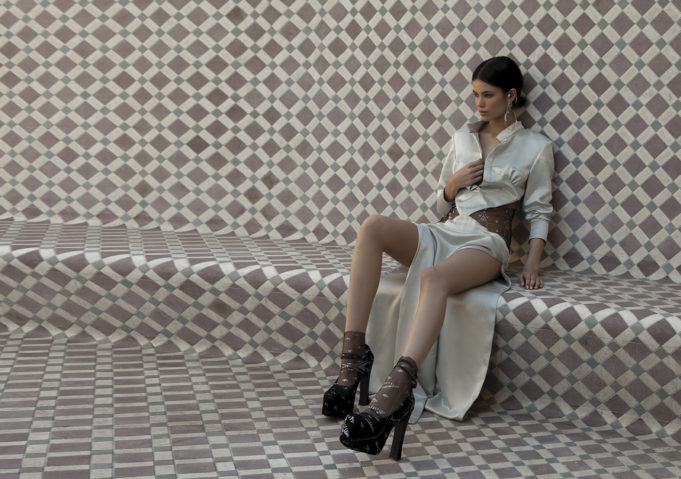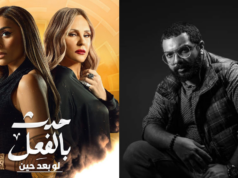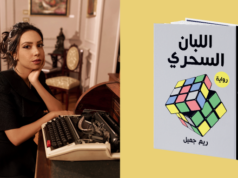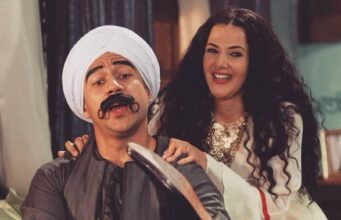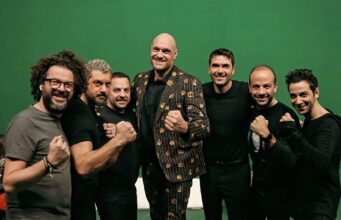She is not just “another designer” and doesn’t aspire to be. However, what she does aspire to become is a designer with an impact. Anne Marie Kirollos likes to design for a cause, to send a message and to make a difference. In her Voyage Aux Bords Du Nil 1940 collection, Anne Marie represented Egyptian women, featuring their essence of empowerment. This wouldn’t have been possible if it weren’t for her passion, dedication and hard work.


Can you tell us about your childhood? What first triggered your sense of fashion?
I was immersed in it since a very young age as I was brought up in a family that was heavily involved in the fashion and textiles industry in Egypt. My grandfather is a chemist who founded a vertically integrated business that does everything from weaving, to dying fabric and producing final garments. Similarly, my mom was also drawn to the fashion industry and followed in his footsteps by creating her own brands; ‘BTM, Marie Louis, Marie Bishara’ and many others. Not only did my mother create her own brands, but she and my family also manufacture and export garments for international high-end brands such as Calvin Klein and Ralph Lauren. Our family also produces uniforms for luxury hotels and airlines. I was born in it, I learned it, and I can’t imagine doing anything else.
Other than fashion, what else are you passionate about?
One of the things that I’m most passionate about at the moment is the revival of dying arts and crafts within Egypt and the effect of this on the artisans. Some of which include the making of Telli, an Egyptian textile where cotton and linen were merged to make a mesh that was embroidered with small strips of 14 karat gold or silver (now with metal thread) and dates back to Ancient Egypt. They use a single stitch technique; this means that the artesian makes one stitch at a time. They cut the thread and move on to the next stitch; therefore, this gives the same pattern on both sides of the fabric. It can take up to 15 days to make a scarf that is around half a meter.
The revival of Telli during the past decade has demonstrated particular shifts in the role of women in the Egyptian society, highlighting the complex gender relations that arise out of a growing Islamic influence. Telli points to how other dying arts such as Sadaf and Tapestry might be revived and sustained within the Egyptian economy and continue to stand for enduring values of the country’s rich tradition and history.


Why did you choose Central Saint Martins to study fashion?
Everything came gradually. At the age of 13, I went to a fashion summer camp that was associated with Central Saint Martins and they advertised about an Art A-levels boarding school in London, so I took my chances and applied when I was 15 without telling my parents. When I got my acceptance letter, I showed it to my parents and succeeded to convince them to let me travel. Then I graduated from the International School of Creative Arts, being one of only two students in my entire graduating class to be accepted into Central Saint Martins, also known as “the Harvard School of Fashion”. I am really grateful and lucky to have been from the very few students who get accepted every year!
Did you face any obstacles when you decided to tell your parents or were they supportive?
Not at all, my parents were very supportive. Of course they were worried about me leaving alone at the young age of 16, but they did not want me to miss out on an opportunity like this so they agreed!


Where do you get your inspiration from?
I get my inspiration from everywhere! I try to see life from a different perspective every day. I go to cultural events, museums and exhibitions. It’s very important to just put yourself out there and explore life; that’s what attracts me the most and always keeps me on my toes to learn new things and strive for more innovative approaches in my work. At the end of the day, I mostly draw my inspiration from my heritage as an Egyptian.
Who are your design role models?
My mother, Marie Louis, is my role model; not only in work but in her lifestyle as well. She’s always been a working mother, who perfectly handled both aspects of her life; being successful at work and always being there for her family. And that is why I see her as a role model and a superwoman! For you to understand, let me briefly run you through some of her work obligations. She runs factories, projects, is a member of the Egyptian National Women’s Council and Founder of an organization called Ana el Masry that provides street children with essential care and helps them become integrated members of society. This organization not only houses the children, but also educates and rehabilitates them. On top of all that, she is also my best friend and the anchor to my family. To me, she is the kindest and bravest woman I have met and will ever meet, and I hope one day I can be a well rounded designer like she is.


Well, my Graduate Collection was my first actual collection. From the pieces I designed, my favourite is the Pinstripe Suit. My inspiration came from Luxor city – not the historical Luxor that comes to mind – but the one where the Ghawazee dancers first landed in Egypt. It’s a very literal translation of the 1940’s menswear, and embraces the juxtaposition between sheer fabric and tailoring techniques.
Describe your designs in 3 words.
Tailored. Elegant. Modern.


Was there any moment you felt like you couldn’t go any longer or thought that designing wasn’t your thing? And if yes, how did you get over it?
Of course and if a designer tells you otherwise, let me tell you they are lying! I see how it is with my mother, running factories and businesses. I also went to the most competitive fashion school in the world. Over there, people tend to hide their work, no one gives you advice, tutors look down on your work, harshly criticize; they purposely try to break you to see how you will handle the pressure of the real fashion world! There’s a personality that you have to acquire in order to survive in the industry. During my last academic year studying fashion, many people around me dropped out and had difficulty with the workload and there were many times when I thought the stress was too much, but I learned how to persevere and work hard and I got through it.
What is the experience that you will never forget? Hilarious, embarrassing.
That’s for me to know, and you to never find out!


What do you aspire to do with your talent?
I have big dreams and goals with an aim to support the fashion industry in Egypt. To be honest, I don’t want to be “just another designer” so I’m taking baby steps to make my dreams happen. I can’t really tell you about them now, you’ll just have to wait and see!
What do you think should improve in the fashion industry in Egypt?
A lot. But I can tell you, we have amazing potential!


Who are you favourite Egyptian designers at the moment?
I don’t have a favourite, but I appreciate accessory designers such as Okhtein. From their ethical point of view and their branding strategies, I believe the brand is very well-thought through, which is why they stand out at what they do. In terms of fashion, Marie Bishara! It is the international line of Marie Louis that has not yet been launched in Egypt. It is quite phenomenal!
What was the inspiration behind your collection “Voyage aux Bords du Nil”?
My collection revolves around a journey down the Nile taken by a woman in the 1940’s as she travels through what is considered by the concept of orientalism as the “Timeless” Egypt. My muse is a well-traveled, cosmopolitan, cultured young lady. She is the definition of allure from attitude to looks. As she stops into the cities, each outfit she wears is expressive of the different cities within Egypt and carries different cultures that have not been fully investigated by the West nor by Egyptians themselves.
Through intricate research, I discovered the origin of each city where the Nile cruise will stop and juxtaposed it with the “modern 1940’s” in Egypt. This is the Golden Age of Cinema and when the British were based in Egypt – seemingly “everything in Egypt was desirable by the West.” Most of my collection uses materials that encompass what we see as Egyptian “dying art”, or arts that are not necessarily promoted within the culture and the demand for them is weak.
These arts are beautifully crafted and carry the Egyptian history and by using them in my collection I am able to promote these arts in a different way so that other designers in all different fields may incorporate these textiles/crafts and create the demand for it once again. Each art/craft that I will be using carries a different unique story, some of their revival and others of their extinction. The arts include; Tulle Bel Telli, tent-making, glass-blowing and Sadaf Jewelry boxes. Reviving these arts will help empower women within the Egyptian society and break extremist social stereotypes as many of these crafts are “women appropriate”.


Photoshoot:
Fashion Designer: Anne Marie K.
Set Design & Styling: Sonia Birman & Pavel Dler
Jewellery Designer: Vicktoria Matsuka
Models: Nadine Mendes (Elite), Georgie Sladen (Nevs), Chole Borges (The Hive Management) & Lavina (Milk Managment)
Make-up & Hair: Mattie White
Carpet Sponsorship: Sharafi & Co


